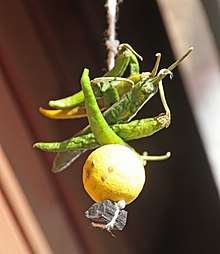Alakshmi
In Hinduism, Alakshmi (Devanāgari: अलक्ष्मी; from the roots अ (a): "not" and लक्ष्मी (Lakshmi): "goddess of fortune", figurative meaning "goddess of misfortune") meaning "not Lakshmi". She is described as being “cow-repelling, antelope-footed,and bull-toothed."[2] Or she “has dry shriveled up body, sunken cheeks, thick lips, and beady eyes and that she rides a donkey."[2] She is not mentioned by name in the Vedic, Upanishadic or early Puranic literature, but all aspects of Alakshmi match those of the Rig Vedic goddess Nirṛti. In Padma Purana, the cosmology includes her where the samudra manthan creates both good and bad of everything that emerges.[3] That which is inauspicious and bad emerges first, more effort creates the auspicious and good, according to Padma Purana.[3] First Alakshmi emerges, then Lakshmi appears during the Samudra manthan.[4] Gods send Alakshmi to go dwell amongst pernicious persons, give them poverty and grief.[3] She as the asura of inauspiciousness and grief is the opposite of Lakshmi the goddess of auspiciousness and joy. Alakshmi is sometimes referred to be another name of Jyestha. Alakshmi is also known as Kalahapriya and Daridara, and the elder sisterly opposite of Lakshmi.[5]

| Alakshmi | |
|---|---|
Misfortune and grief | |
| Other names | Jyestha, Nirṛti |
| Devanagari | अलक्ष्मी |
| Mount | Donkey |
| Texts | Linga Purana[1] Shri Suktam |
| Personal information | |
| Siblings | Lakshmi |
| Spouse | Kali (demon) |
According to Chakrabarty, “It was said that when she entered a household, Alakshmi brought jealousy and malice in her trail. Brothers fell out with each other, families and their male lineages (kula) faced ruin and destruction."[6]
The spouse of Alakshmi is demon Kali.
References
- Linga Purana - Part 2, English Translation by J.L.Shastri (1951), Chapter 6: The origin and activities of Alakshmi
- Pattanaik, Devdutt. Lakshmi: The Goddess of Wealth and Fortune-An Introduction. Vakils Feffer & Simons Ltd, 2003 (ISBN 8187111585)
- Tracy Pintchman (2005). Guests at God's Wedding: Celebrating Kartik among the Women of Benares. SUNY Press. pp. 48–49. ISBN 978-0-7914-8256-8.
- Krishna, Nanditha. The Book of Vishnu. Penguin Global, 2001 (ISBN 0670049077)
- Kirin Narayan (2011). Storytellers, Saints, and Scoundrels: Folk Narrative in Hindu Religious Teaching. University of Pennsylvania Press. p. 223. ISBN 0-8122-0583-9.
- Chakrabarty, Dipesh. Provincializing Europe. Princeton University Press, 2000 (ISBN 0691049092)
External links
| Wikiquote has quotations related to: Alakshmi |
